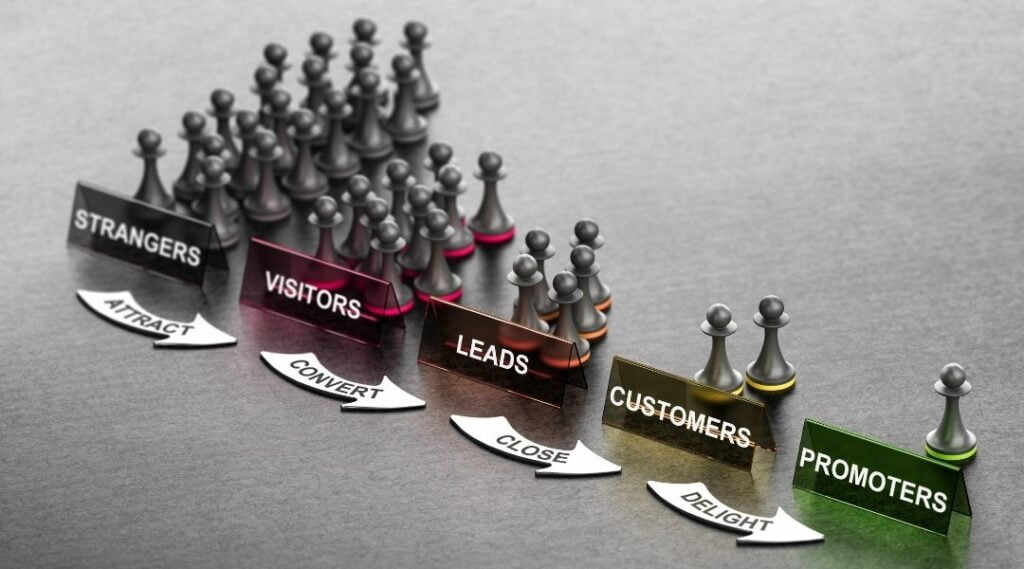When it comes to sales and marketing, there are a lot of funnel-shaped things. We’re not sure why funnels keep appearing, but they are certainly an effective model to work with! But as a marketing company, we are most interested in the marketing funnel, which is all about describing the customer’s journey from awareness to purchase with your company. And one of the things we’re asked about a lot is what exactly a marketing funnel is, why it matters, and how do you create one for your business?
What is a Marketing Funnel?
On the surface, a marketing funnel is pretty simple. It’s the journey a customer takes from their first interaction to purchasing, and the activities you can do as a business to encourage them at each point to move to the next stage. Think of it like a roadmap for your customer acquisition, made up of all sorts of different marketing activities. From social media and paid ads to blogs, newsletters and even physical flyers. But though it might seem like an easy thing on the surface, marketing funnels can get complicated pretty quickly because:
- There are dozens of different marketing channels you could use.
- You may have multiple target markets, each with its own pain points, making it challenging to create one funnel for all.
- Each customer will have a different level of awareness of your brand when they come into contact with you.
All of which can lead to a marketing funnel that looks more like a spiral. But since only 2% of purchases are made on first contact with your customers, having one is essential.
Stages Of The Marketing Funnel
Ultimately, you have a lot of control over the stages in your marketing funnel. There is no hard and fast rule, and you should experiment to find a process that works for your business and your customers. But there are some best practices, generally speaking, when it comes to the stages of your marketing funnel. Modern marketing funnels tend to include the following stages in various forms:
Awareness: A prospect becomes aware of the existence of your business.
Interest: A prospect gains some more knowledge about your business.
Consideration: A prospect actively learns about and engages with your product or service.
Intent: A prospect demonstrates their interest in purchasing from you, usually by getting in touch.
Evaluation: A prospect weighs up the options to make a final decision about buying.
Purchase: The prospect makes the decision to buy from you and converts to a customer.
A much more simplified version of this funnel is called the AIDA model, and we more about that in this blog.

Creating Your Marketing Funnel
Now you know what a marketing funnel is, you might have already been able to identify a rough outline for yours at the moment. So how can you harness that and turn it into a clear, refined marketing funnel that you can use to attract and convert customers reliably, time and time again? Here are a few things you can do to get the ball rolling:
Know Your Audience
There are two reasons you need to know your audience to create a good marketing funnel. The first is to identify their pains and interests so that you can create content that appeals to them and draws them further into the funnel. Content is a huge driver in marketing funnels, and without relevant content, you may struggle to convert customers. The second is to understand where you would find them. What platforms do they use, where do they spend their time in real life, and what’s the best way to connect with them? This will help you create a more effective strategy moving forward.
Choose Your Stages
Your marketing funnel can be as long or as short as you would like it to be. While the main stages are usually the ones above, you can have multiple layers within them, or even add in new ones. Or you can cut some stages out – for example, if post-purchase stages aren’t relevant to your business. Tailor your marketing funnel to fit your business, rather than trying to rigidly adhere to a model.
Narrow Down Your Tactics
Now, look at what tactics and channels you may want to use in your funnel, and what type of content fits at each stage. This should match up with the kind of content your audience would find valuable at each stage of the funnel. For example, you might use newsletters, PPC ads and blog posts to attract prospects, publish whitepapers and e-books as a way to nurture them, and case studies to convert them. You have a huge range of options to choose from, so finding something effective that works for you should be simple.
Use A CRM System

A big part of having a marketing funnel in place is the ability to track where prospects are in the process so that you can provide targeted content at the right moments. To do this you should use a CRM system of your choice. This allows you to keep track of your prospects, manage your relationship with them, communicate effectively and see what their behaviour is within your marketing funnel. A CRM can really take your marketing efforts to the next level.
It’s important to remember that while your funnel might look nice and neat on paper, it probably won’t play out that way all the time in real life. People will jump around, move backwards and then leap forwards as they move through the funnel, and some might even go through it several times before they actually commit to buying from you. This can influence how you create your funnel, or how you react to customers as they make their journey.
At Lion Spirit Media marketing funnels are a critical part of the process when creating tailored digital marketing strategies for our customers. By understanding the customer journey and their decision making, we are able to create marketing campaigns that hit the right notes at the right time and shepherd customers down that marketing funnel and into action. Using a unique blend of strategy, content marketing, SEO and paid advertising, our strategies align with your customer journey at every step and create the ideal climate for them to buy from you. If you would like to know more, just get in touch with the team today.





0 Comments